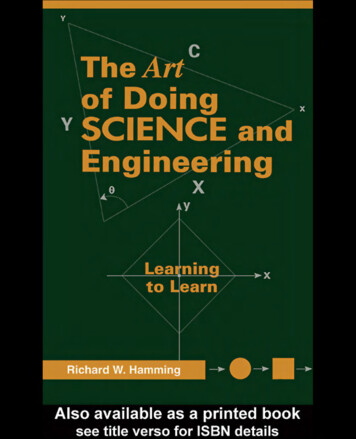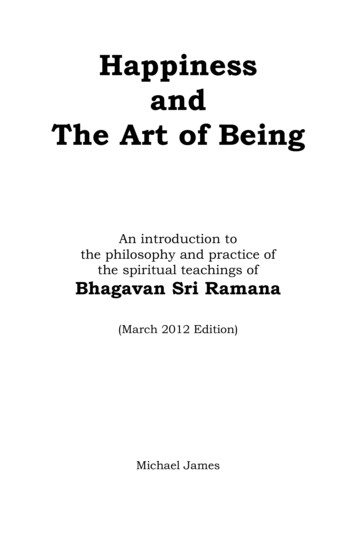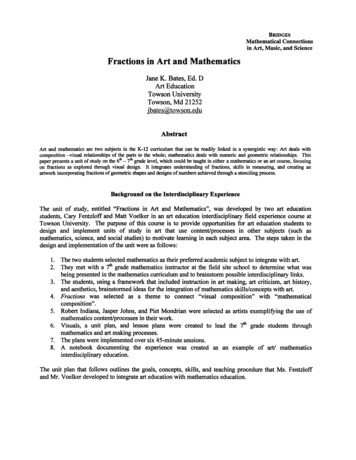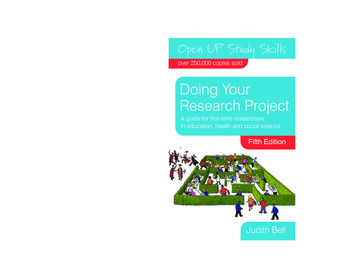
Transcription
The Art of Doing Science and Engineering
The Art of Doing Science andEngineeringLearning to LearnRichard W.HammingU.S. Naval Postgraduate SchoolMonterey, CaliforniaGORDON AND BREACH SCIENCE PUBLISHERSAustralia Canada China France Germany India Japan Luxembourg Malaysia The Netherlands Russia Singapore Switzerland Thailand United Kingdom
This edition published in the Taylor & Francis e-Library, 2005.“To purchase your own copy of this or any of Taylor & Francis or Routledge’s collection of thousands of eBooks please go towww.eBookstore.tandf.co.uk.”Copyright 1997 OPA (Overseas Publishers Association)Amsterdam B.V.Published in The Netherlands under licenseby Gordon and Breach Science Publishers.All rights reserved.No part of this book may be reproduced or utilized in anyform or by any means, electronic or mechanical, includingphotocopying and recording, or by any information storageor retrieval system, without permission in writing from thepublisher. Printed in India.Amsteldijk 1661st Floor1079 LH AmsterdamThe NetherlandsBritish Library Cataloguing in Publication DataHamming, R.W. (Richard Wesley), 1915–The art of doing science and engineering: learning tolearn1. Science 2. EngineeringI. Title500ISBN 0-203-45071-X Master e-book ISBNISBN 0-203-45913-X (Adobe eReader Format)ISBN 90-5699-501-4 (Print Edition)
ndations of the Digital (Discrete) Revolution93History of Computer—Hardware174History of Computer—Software245History of Computer Applications336Limits of Computer Applications—AI—I407Limits of Computer Applications—AI—II478Limits of Computer Applications—AI—III559n-Dimensional Space5710Coding Theory—I6711Coding Theory—II7412Error Correcting Codes8113Information Theory8914Digital Filters—I9715Digital Filters—II10716Digital Filters—III11517Digital I13520Simulation—III14121Fiber Optics15122Computer Aided Instruction—CAI157
v23Mathematics16324Quantum e Data18728Systems Engineering19529You Get What You Measure20230You and Your Research209Index216
PREFACEAfter many years of pressure and encouragement from friends, I decided to write up the graduate course inengineering I teach at the U.S.Naval Postgraduate School in Monterey, California. At first I concentrated onall the details I thought should be tightened up, rather than leave the material as a series of somewhatdisconnected lectures. In class the lectures often followed the interests of the students, and many of the laterlectures were suggested topics in which they expressed an interest Also, the lectures changed from year toyear as various areas developed. Since engineering depends so heavily these days on the correspondingsciences, I often use the terms interchangeably.After more thought I decided that since I was trying to teach “style” of thinking in science andengineering, and “style” is an art, I should therefore copy the methods of teaching used for the other arts—once the fundamentals have been learned. How to be a great painter cannot be taught in words; one learnsby trying many different approaches that seem to surround the subject. Art teachers usually let the advancedstudent paint, and then make suggestions on how they would have done it, or what might also be tried, moreor less as the points arise in the student’s head—which is where the learning is supposed to occur! In thisseries of lectures I try to communicate to students what cannot be said in words—the essence of style inscience and engineering. I have adopted a loose organization with some repetition since this often occurs inthe lectures. There are, therefore, digressions and stories—with some told in two different places—all in thesomewhat rambling, informal style typical of lectures.I have used the “story” approach, often emphasizing the initial part of the discovery, because I firmlybelieve in Pasteur’s remark, “Luck favors the prepared mind.” In this way I can illustrate how theindividual’s preparation before encountering the problem can often lead to recognition, formulation, andsolution. Great results in science and engineering are “bunched” in the same person too often for success tobe a matter of random luck.Teachers should prepare the student for the student’s future, not for the teacher’s past. Most teachersrarely discuss the important topic of the future of their field, and when this is pointed out they usually reply:“No one can know the future.” It seems to me the difficulty of knowing the future does not absolve theteacher from seriously trying to help the student to be ready for it when it comes. It is obvious theexperience of an individual is not necessarily that of a class of individuals; therefore, any one person’sprojection into the future is apt to be somewhat personal and will not be universally accepted. This does notjustify reverting to impersonal surveys and losing the impact of the personal story.Since my classes are almost all carefully selected navy, marine, army, air force, and coast guard studentswith very few civilians, and, interestingly enough, about 15% very highly selected foreign military, thestudents face a highly technical future—hence the importance of preparing them for their future and not justour past.
viiThe year 2020 seems a convenient date to center the preparation for their future—a sort of 20/20foresight, as it were. As graduate students working toward a master’s degree, they have the basics well inhand. That leaves me the task of adding “style” to their education, which in practice is usually the differencebetween an average person and a great one. The school has allowed me great latitude in trying to teach acompletely non-technical course; this course “complements” the more technical ones. As a result, myopening words, occasionally repeated, are: “There is really no technical content in the course, though I will,of course, refer to a great deal of it, and hopefully it will generally be a good review of the fundamentals ofwhat you have learned. Do not think it is the content of the course—it is only illustrative material. Style ofthinking is the center of the course.”The subtitle of this book, Learning to Learn, is the main solution I offer to help students cope with therapid changes they will have to endure in their fields. The course centers around how to look at and thinkabout knowledge, and it supplies some historical perspectives that might be useful.This course is mainly personal experiences I have had and digested, at least to some extent. Naturally onetends to remember one’s successes and forget lesser events, but I recount a number of my spectacularfailures as clear examples of what to avoid. I have found that the personal story is far, far more effectivethan the impersonal one; hence there is necessarily an aura of “bragging” in the book that is unavoidable.Let me repeat what I earlier indicated. Apparently an “art”— which almost by definition cannot be putinto words—is probably best communicated by approaching it from many sides and doing so repeatedly,hoping thereby students will finally master enough of the art, or if you wish, style, to significantly increasetheir future contributions to society. A totally different description of the course is: it covers all kinds ofthings that could not find their proper place in the standard curriculum.The casual reader should not be put off by the mathematics; it is only “window dressing” used toillustrate and connect up with earlier learned material. Usually the underlying ideas can be grasped from thewords alone.It is customary to thank various people and institutions for help in producing a book. Thanks obviouslygo to AT&T Bell Laboratories, Murray Hill, New Jersey, and to the U.S.Naval Postgraduate School,especially the Department of Electrical and Computer Engineering, for making this book possible.
INTRODUCTIONThis book is concerned more with the future and less with the past of science and engineering. Of coursefuture predictions are uncertain and usually based on the past; but the past is also much more uncertain—oreven falsely reported—than is usually recognized. Thus we are forced to imagine what the future willprobably be. This course has been called"Hamming on Hamming" since it draws heavily on my own pastexperiences, observations, and wide reading.There is a great deal of mathematics in the early part because almost surely the future of science andengineering will be more mathematical than the past, and also I need to establish the nature of thefoundations of our beliefs and their uncertainties. Only then can I show the weaknesses of our currentbeliefs and indicate future directions to be considered.If you find the mathematics difficult, skip those early parts. Later sections will be understandableprovided you are willing to forgo the deep insights mathematics gives into the weaknesses of our currentbeliefs. General results are always stated in words, so the content will still be there but in a slightly dilutedform.
1OrientationThe purpose of this course is to prepare you for your technical future. There is really no technical content inthe course, though I will, of course, refer to a great deal of it, and hopefully it will generally be a goodreview of the fundamentals you have learned. Do not think the technical content is the course—it is onlyillustrative material. Style of thinking is the center of the course. I am concerned with educating and nottraining you.I will examine, criticize, and display styles of thinking. To illustrate the points of style I will often usetechnical knowledge most of you know, but, again, it will be, I hope, in the form of a useful review whichconcentrates on the fundamentals. You should regard this as a course which complements the manytechnical courses you have learned. Many of the things I will talk about are things which I believe you oughtto know but which simply do not fit into courses in the standard curriculum. The course exists because thedepartment of Electrical and Computer Engineering of the Naval Postgraduate School recognizes the needfor both a general education and the specialized technical training your future demands.The course is concerned with “style”, and almost by definition style cannot be taught in the normalmanner by using words. I can only approach the topic through particular examples, which I hope are wellwithin your grasp, though the examples come mainly from my 30 years in the mathematics department ofthe Research Division of Bell Telephone Laboratories (before it was broken up). It also comes from yearsof study of the work of others.The belief anything can be “talked about” in words was certainly held by the early Greek philosophers,Socrates (469–399), Plato (427–347), and Aristotle (384–322). This attitude ignored the current mysterycults of the time who asserted you had to “experience” some things which could not be communicated inwords. Examples might be the gods, truth, justice, the arts, beauty, and love. Your scientific training hasemphasized the role of words, along with a strong belief in reductionism, hence to emphasize the possiblelimitations of language I shall take up the topic in several places in the book. I have already said “style” issuch a topic.I have found to be effective in this course, I must use mainly first hand knowledge, which implies I breaka standard taboo and talk about myself in the first person, instead of the traditional impersonal way ofscience. You must forgive me in this matter, as there seems to be no other approach which will be aseffective. If I do not use direct experience then the material will probably sound to you like merely piouswords and have little impact on your minds, and it is your minds I must change if I am to be effective.This talking about first person experiences will give a flavor of “bragging”, though I include a number ofmy serious errors to partially balance things. Vicarious learning from the experiences of others savesmaking errors yourself, but I regard the study of successes as being basically more important than the studyof failures. As I will several times say, there are so many ways of being wrong and so few of being right,
2CHAPTER 1studying successes is more efficient, and furthermore when your turn comes you will know how to succeedrather than how to fail!I am, as it were, only a coach. I cannot run the mile for you; at best I can discuss styles and criticizeyours. You know you must run the mile if the athletics course is to be of benefit to you—hence you mustthink carefully about what you hear or read in this book if it is to be effective in changing you—which mustobviously be the purpose of any course. Again, you will get out of this course only as much as you put in,and if you put in little effort beyond sitting in the class or reading the book, then it is simply a waste of yourtime. You must also mull things over, compare what I say with your own experiences, talk with others, andmake some of the points part of your way of doing things.Since the subject matter is “style”, I will use the comparison with teaching painting. Having learned thefundamentals of painting, you then study under a master you accept as being a great painter; but you knowyou must forge your own style out of the elements of various earlier painters plus your native abilities. Youmust also adapt your style to fit the future, since merely copying the past will not be enough if you aspire tofuture greatness—a matter I assume, and will talk about often in the book. I will show you my style as best Ican, but, again, you must take those elements of it which seem to fit you, and you must finally create yourown style. Either you will be a leader, or a follower, and my goal is for you to be a leader. You cannotadopt every trait I discuss in what I have observed in myself and others; you must select and adapt, andmake them your own if the course is to be effective.Even more difficult than what to select is that what is a successful style in one age may not be appropriateto the next age! My predecessors at Bell Telephone Laboratories used one style; four of us who came in allat about the same time, and had about the same chronological age, found our own styles and as a result werather completely transformed the overall style of the Mathematics Department, as well as many parts of thewhole Laboratories. We privately called ourselves “The four young Turks”, and many years later I foundtop management had called us the same!I return to the topic of education. You all recognize there is a significant difference between educationand training.Education is what, when, and why to do things, Training is how to do it.Either one without the other is not of much use. You need to know both what to do and how to do it. I havealready compared mental and physical training and said to a great extent in both you get out of it what youput into it—all the coach can do is suggest styles and criticize a bit now and then. Because of the usual sizeof these classes, or because you are reading the book, there can be little direct criticism of your thinking byme, and you simply have to do it internally and between yourselves in conversations, and apply the things Isay to your own experiences. You might think education should precede training, but the kind of educating Iam trying to do must be based on your past experiences and technical knowledge. Hence this inversion ofwhat might seem to be reasonable. In a real sense I am engaged in “meta-education”, the topic of the courseis education itself and hence our discussions must rise above it—“meta-education”, just as metaphysics wassupposed to be above physics in Aristotle’s time (actually “follow”, “transcend” is the translation of“meta”).This book is aimed at your future, and we must examine what is likely to be the state of technology(Science and Engineering) at the time of your greatest contributions. It is well known that since about IsaacNewton’s time (1642–1727) knowledge of the type we are concerned with has about doubled every 17years. First, this may be measured by the books published (a classic observation is libraries must doubletheir holdings every 17 years if they are to maintain their relative position). Second, when I went to Bell
ORIENTATION3Telephone Laboratories in 1946 they were trying to decrease the size of the staff from WW-II size down toabout 5500. Yet during the 30 years I was there I observed a fairly steady doubling of the number ofemployees every 17 years, regardless of the administration having hiring freezes now and then, and suchthings. Third, the growth of the number of scientists generally has similarly been exponential, and it is saidcurrently almost 90% of the scientists who ever lived are now alive! It is hard to believe in your future therewill be a dramatic decrease in these expected rates of growth, hence you face, even more than I did, theconstant need to learn new things.Here I make a digression to illustrate what is often called “back of the envelop calculations”. I havefrequently observed great scientists and engineers do this much more often than “the run of the mill”people, hence it requires illustration. I will take the above two statements, knowledge doubles every 17years, and 90% of the scientists who ever lived are now alive, and ask to what extent they are compatible.The model of the growth of knowledge and the growth of scientists assumed are both exponential, with thegrowth of knowledge being proportional to the number of scientists alive. We begin by assuming thenumber scientists at any time t isand the amount of knowledge produced annually has a constant k of proportionality to the number ofscientists alive. Assuming we begin at minus infinity in time (the error is small and you can adjust it toNewton’s time if you wish), we have the formulahence we know b. Now to the other statement. If we allow the lifetime of a scientist to be 55 years (it seemslikely that the statement meant living and not practicing, but excluding childhood) then we havewhich is very close to 90%.Typically the first back of the envelop calculations use, as we did, definite numbers where one has a feelfor things, and then we repeat the calculations with parameters so you can adjust things to fit the data betterand understand the general case. Let the doubling period be D, and the lifetime of a scientist be L. The firstequation now becomesand the second becomes:
4CHAPTER 1With D 17 years we have 17 3.3219 56.47 years for the lifetime of a scientist, which is close to the 55we assumed. We can play with ratio of L/D until we find a slightly closer fit to the data (which wasapproximate, though I believe more in the 17 years for doubling than I do in the 90%). Back of the envelopcomputing indicates the two remarks are reasonably compatible. Notice the relationship applies for all timeso long as the assumed simple relationships hold.The reason back of the envelop calculations are widely used by great scientists is clearly revealed—youget a good feeling for the truth or falsity of what was claimed, as well as realize which factors you wereinclined not to think about, such as exactly what was meant by the lifetime of a scientist. Having done thecalculation you are much more likely to retain the results in your mind. Furthermore, such calculations keepthe ability to model situations fresh and ready for more important applications as they arise. Thus Irecommend when you hear quantitative remarks such as the above you turn to a quick modeling to see ifyou believe what is being said, especially when given in the public media like the press and TV. Very oftenyou find what is being said is nonsense, either no definite statement is made which you can model, or if youcan set up the model then the results of the model do not agree with what was said. I found it very valuableat the physics table I used to eat with; I sometimes cleared up misconceptions at the time they were beingformed, thus advancing matters significantly.Added to the problem of the growth of new knowledge is the obsolescence of old knowledge. It isclaimed by many the half-life of the technical knowledge you just learned in school is about 15 years—in 15years half of it will be obsolete (either we have gone in other directions or have replaced it with newmaterial). For example, having taught myself a bit about vacuum tubes (because at Bell TelephoneLaboratories they were at that time obviously important) I soon found myself helping, in the form ofcomputing, the development of transistors—which obsoleted my just learned knowledge!To bring the meaning of this doubling down to your own life, suppose you have a child when you are xyears old. That child will face, when it is in college, about y times the amount you faced.yxfactor of increaseyears234567817273439444851This doubling is not just in theorems of mathematics and technical results, but in musical recordings ofBeethoven’s Ninth, of where to go skiing, of TV programs to watch or not to watch. If you were at times awedby the mass of knowledge you faced when you went to college, or even now, think of your children’stroubles when they are there! The technical knowledge involved in your life will quadruple in 34 years, andmany of you will then be near the high point of your career. Pick your estimated years to retirement andthen look in the left-hand column for the probable factor of increase over the present current knowledgewhen you finally quit!What is my answer to this dilemma? One answer is you must concentrate on fundamentals, at least whatyou think at the time are fundamentals, and also develop the ability to learn new fields of knowledge when
ORIENTATION5they arise so you will not be left behind, as so many good engineers are in the long run. In the position Ifound myself in at the Laboratories, where I was the only one locally who seemed (at least to me) to have afirm grasp on computing, I was forced to learn numerical analysis, computers, pretty much all of thephysical sciences at least enough to cope with the many different computing problems which arose and whosesolution could benefit the Labs, as well as a lot of the social and some the biological sciences. Thus I am aveteran of learning enough to get along without at the same time devoting all my effort to learning newtopics and thereby not contributing my share to the total effort of the organization. The early days oflearning had to be done while I was developing and running a computing center. You will face similarproblems in your career as it progresses, and, at times, face problems which seem to overwhelm you.How are you to recognize “fundamentals”? One test is they have lasted a long time. Another test is fromthe fundamentals all the rest of the field can be derived by using the standard methods in the field.I need to discuss science vs. engineering. Put glibly:In science if you know what you are doing you should not be doing it.In engineering if you do not know what you are doing you should not be doing it.Of course, you seldom, if ever, see either pure state. All of engineering involves some creativity to cover theparts not known, and almost all of science includes some practical engineering to translate the abstractionsinto practice. Much of present science rests on engineering tools, and as time goes on, engineering seems toinvolve more and more of the science part. Many of the large scientific projects involve very seriousengineering problems—the two fields are growing together! Among other reasons for this situation is almostsurely we are going forward at an accelerated pace, and now there is not time to allow us the leisure whichcomes from separating the two fields. Furthermore, both the science and the engineering you will need foryour future will more and more often be created after you left school. Sorry! But you will simply have toactively master on your own the many new emerging fields as they arise, without having the luxury of beingpassively taught.It should be noted that engineering is not just applied science, which is a distinct third field (though it isnot often recognized as such) which lies between science and engineering.I read somewhere there are 76 different methods of predicting the future—but very number suggests thereis no reliable method which is widely accepted. The most trivial method is to predict tomorrow will beexactly the same as today—which at times is a good bet. The next level of sophistication is to use the currentrates of change and to suppose they will stay the same—linear prediction in the variable used. Which variableyou use can, of course, strongly affect the prediction made! Both methods are not much good for long-termpredictions, however.History is often used as a long-term guide; some people believe history repeats itself and others believeexactly the opposite! It is obvious:The past was once the future and the future will become the past.In any case I will often use history as a background for the extrapolations I make. I believe the bestpredictions are based on understanding the fundamental forces involved, and this is what I depend onmainly. Often it is not physical limitations which control but rather it is human made laws, habits, andorganizational rules, regulations, personal egos, and inertia, which dominate the evolution to the future. Youhave not been trained along these lines as much as I believe you should have been, and hence I must be carefulto include them whenever the topics arise.
6CHAPTER 1There is a saying,“Short term predictions are always optimistic and long term predictions are alwayspessimistic”. The reason, so it is claimed, the second part is true is for most people the geometric growthdue to the compounding of knowledge is hard to grasp. For example for money a mere 6% annual growthdoubles the money in about 12 years! In 48 years the growth is a factor of 16. An example of the truth ofthis claim that most long-term predictions are low is the growth of the computer field in speed, in density ofcomponents, in drop in price, etc. as well as the spread of computers into the many corners of life. But thefield of Artificial Intelligence (AI) provides a very good counter example. Almost all the leaders in the fieldmade long-term predictions which have almost never come true, and are not likely to do so within yourlifetime, though many will in the fullness of time.I shall use history as a guide many times in spite of Henry Ford, Sr. saying, “History is Bunk”. ProbablyFord’s points were:1. History is seldom reported at all accurately, and I have found no two reports of what happened at LosAlamos during WW-II seems to agree.2. Due to the pace of progress the future is rather disconnected from the past; the presence of the moderncomputer is an example of the great differences which have arisen.Reading some historians you get the impression the past was determined by big trends, but you also havethe feeling the future has great possibilities. You can handle this apparent contradiction in at least four ways:1. You can simply ignore it.2. You can admit it.3. You can decide the past was a lot less determined than historians usually indicate and individualchoices can make large differences at times. Alexander the Great, Napoleon, and Hitler had greateffects on the physical side of life, while Pythagoras, Plato, Aristotle, Newton, Maxwell, and Einsteinare examples on the mental side.4. You can decide the future is less open ended than you would like to believe, and there is really lesschoice than there appears to be.It is probable the future will be more limited by the slow evolution of the human animal and thecorresponding human laws, social institution, and organizations than it will be by the rapid evolution oftechnology.In spite of the difficulty of predicting the future and that:Unforeseen technological inventions can completely upset the most careful predictions,you must try to foresee the future you will face. To illustrate the importance of this point of trying to foreseethe future I often use a standard story.It is well known the drunken sailor who staggers to the left or right with n independent random steps will,steps from the origin. But if there is a pretty girl in one direction, then hison the average, end up aboutsteps will tend to go in that direction and he will go a distance proportional to n. In a lifetime of many, manyindependent choices, small and large, a career with a vision will get you a distance proportional to n, whileIn a sense, the main difference between those who go far andno vision will get you only the distancethose who do not is some people have a vision and the others do not and therefore can only react to thecurrent events as they happen.
ORIENTATION7One of the main tasks of this course is to start you on the path of creating in some detail your vision ofyour future. If I fail in this I fail in the whole course. You will probably object that if you try to get a visionnow it is likely to be wrong—and my reply is from observation I have seen the accuracy of the visionmatters less than you might suppose, getting anywhere is better than drifting, there are potentially manypaths to greatness for you, and just which path you go on, so long as it takes you to greatness, is none of mybusiness. You must, as in the case of forging your personal style, find your vision of your future career, andthen follow it as best you can.No vision, not much of a future.To what extent history does or does not repeat itself is a moot question. But it is one of the few guides youhave, hence history will often play a large role in my discussions—I am trying to provide you with someperspective as a possible guide to create your vision of your future. The other main tool I have used is anact
what you have learned. Do not think it is the content of the course—it is only illustrative material. Style of thinking is the center of the course.” The subtitle of this book, Learning to Learn, is the mai











